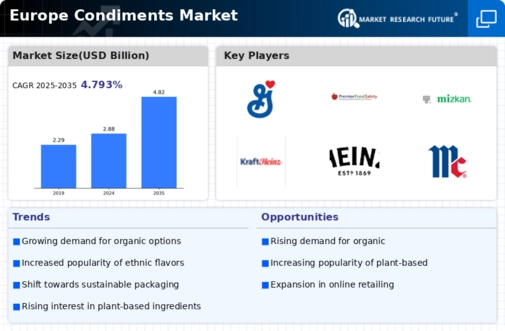Rising Demand for Organic Products
The condiments market in Europe is experiencing a notable shift towards organic products, driven by increasing consumer awareness regarding health and sustainability. As more individuals prioritize natural ingredients, the demand for organic condiments has surged. In 2025, organic condiments accounted for approximately 15% of the total market share, reflecting a growing preference for products free from artificial additives. This trend is likely to continue as consumers seek transparency in food sourcing and production methods. The condiments market is adapting by expanding its organic offerings, which may enhance brand loyalty and attract health-conscious consumers. Furthermore, regulatory frameworks in Europe are increasingly supporting organic farming practices, potentially bolstering the growth of organic condiment products in the coming years.
Growth of E-Commerce and Online Sales
The condiments market in Europe is experiencing a transformation due to the rapid growth of e-commerce and online sales channels. As consumers increasingly turn to online shopping for convenience, the demand for condiments available through digital platforms is rising. In 2025, online sales are expected to account for approximately 25% of total condiment sales, reflecting a shift in consumer purchasing behavior. The condiments market is adapting by enhancing its online presence and optimizing supply chains to meet this demand. This trend not only provides consumers with greater access to a variety of products but also allows brands to reach a broader audience. The integration of technology in marketing and distribution strategies is likely to play a pivotal role in shaping the future of the condiments market.
Culinary Exploration and Ethnic Flavors
The condiments market in Europe is witnessing a significant rise in the popularity of ethnic flavors, as consumers become more adventurous in their culinary choices. This trend is characterized by an increasing interest in diverse cuisines, leading to a demand for condiments that reflect global flavors. In 2025, it is estimated that ethnic condiments will represent around 20% of the overall market, indicating a shift towards more varied taste profiles. The condiments market is responding by introducing innovative products that incorporate spices and ingredients from various cultures, appealing to consumers' desire for unique dining experiences. This exploration of flavors not only enhances meal preparation but also encourages consumers to experiment with new recipes, thereby driving sales in the condiment sector.
Influence of Food Trends and Social Media
The condiments market in Europe is significantly influenced by emerging food trends and the pervasive impact of social media. As consumers increasingly share their culinary experiences online, the demand for trendy condiments is on the rise. In 2025, it is anticipated that social media-driven trends will contribute to a 15% increase in sales of unique and visually appealing condiments. The condiments market is leveraging this phenomenon by creating products that are not only flavorful but also aesthetically pleasing, encouraging consumers to showcase them on social platforms. This interplay between social media and consumer behavior is likely to drive innovation and marketing strategies within the industry, as brands seek to capitalize on viral trends and engage with a digitally-savvy audience.
Sustainability and Eco-Friendly Packaging
Sustainability has emerged as a critical driver in the condiments market in Europe, with consumers increasingly favoring brands that prioritize eco-friendly practices. The demand for sustainable packaging solutions is on the rise, as consumers become more conscious of their environmental impact. In 2025, it is projected that approximately 30% of consumers will actively seek out condiments packaged in recyclable or biodegradable materials. The condiments market is responding by innovating packaging designs that reduce plastic waste and promote sustainability. This shift not only aligns with consumer values but also enhances brand reputation, potentially leading to increased market share. As environmental regulations become more stringent in Europe, companies that adopt sustainable practices may gain a competitive edge in the condiments market.

















Leave a Comment